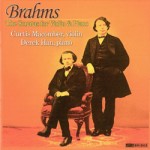Column Name
Title
American Trios. The Claremont Trio plays works for violin, cello, and piano by Zwilich, Kirchner, Bates, and Schoenfield. (Tria Records 884501051019)
Body
A street in upper Manhattan near Juilliard's former home inspired the name of the Claremont Trio, made up of twin sisters Emily and Julia Bruskin, violin and cello, and Donna Kwong, piano, who formed the group in 1999 while they were students at Juilliard. The young musicians show immaculate taste in this imaginative survey of piano trios from the last 50 years. The disk opens with a bolt of lightning—Ellen Taaffe Zwilich's 1987 Trio for Violin, Cello, and Piano. As its raw material, the agitated opening uses a simple four-note figure repeated dozens of times. In contrast, the second movement begins with the violin and cello in mournful unison over dark piano chords, leading to a haunting close. The finale takes an eight-note motif related to the earlier one and tears off madly, and in the process gives the musicians the chance to show how completely they have internalized Zwilich's idiom.
To mark the 90th birthday of Leon Kirchner come his two piano trios, written almost 40 years apart. The first, from 1954, with an untitled opening movement, is a dense drama combining lunging passages with those of flickering delicacy. A stark ending leads directly into an introspective Largo, which though mostly slow, still has outbursts of rapid shifts in tempo. The second of the pair, Trio II (1993), goes by in a single gossamer breath. Skittering passages alternate seamlessly with muted colors, and although the score is scarcely 17 minutes long, it has the scope of a tone poem.
String Band, a delicious gulp by Mason Bates, who studied composition at Juilliard with John Corigliano, uses a prepared piano to create striking wooden knocks, while the violin and cello combine glissandos infused with banjo- and fiddle-like sounds. Animated in its initial pages, the work subsides into a slow, hallucinatory haze. And in Paul Schoenfield's popular Café Music the trio shows meticulous attention to the composer's jazzy rhythms. The Andante Moderato is as nostalgic as a sepia photo from another era, and the finale is a raucous chase through a back alley. The indispensable Adam Abeshouse has recorded the threesome in the popular concert hall at SUNY-Purchase, most notably picking up the unusual timbres in the Bates.
Brahms: The Sonatas for Violin and Piano. Curtis Macomber, violin, and Derek Han, piano. (Bridge 9258)
Among contemporary music fans, violinist Curtis Macomber, who earned a doctorate from Juilliard and is now on the School's faculty, is highly regarded for his work with living composers, making this foray into Brahms sonatas something to treasure. Working with eminent pianist (and fellow Juilliard alum) Derek Han, Macomber offers a straightforward, no-nonsense approach, starting with the mysterious opening of the Sonata in A Major, Op. 100. Phrase by phrase, almost hesitantly, as if being coaxed out of its shell, the violin eventually completes the opening broad melody. The second movement provides a similar sense of discovery, as if Macomber and Han have donned test wings, impishly trying them out. The big-hearted finale shows the duo cutting loose, finding warmth yet never veering into mawkishness.
In the later, darker Sonata in D Minor, Op. 108, Macomber brings out the shadowy moodiness, as if Brahms were trying to convince himself of his happiness but only partially succeeding. Han's playing is especially thoughtful here. The Adagio, relatively tranquil, seems to ask more questions than it answers. The slightly quirky Un poco presto that follows provides a short respite, while gazing forwards and backwards at some of the surrounding uncertainty, while the finale is all nervous energy, alternating between aggression and melancholy.
When we reach the earliest of the three, the Sonata in G Major, Op. 78, with its gently soaring spirit, even its optimism seems perpetually on the verge of sorrow. Its plaintive Adagio has a hymnlike sobriety. Note the understatement here: where some may be tempted to over-emote, Macomber and Han keep things in check. In a fitting ending, the finale finds both artists returning to the sense of wonder that began the recording. Longtime producer-engineer Judith Sherman, working in the American Academy of Arts and Letters, preserves just enough reverberation to frame Macomber's mellow tone, so beautifully supported by Han's agile keyboard work.






